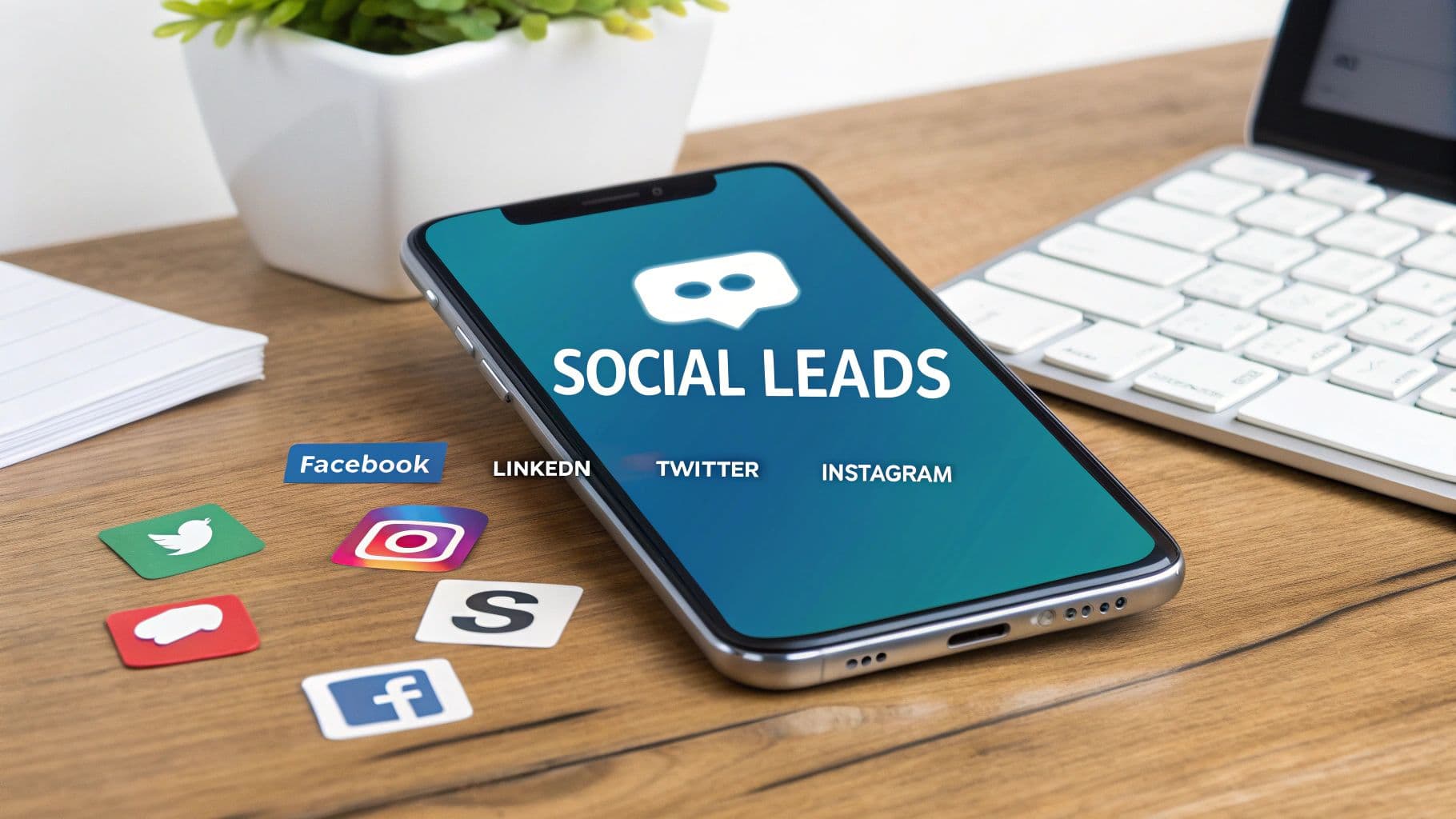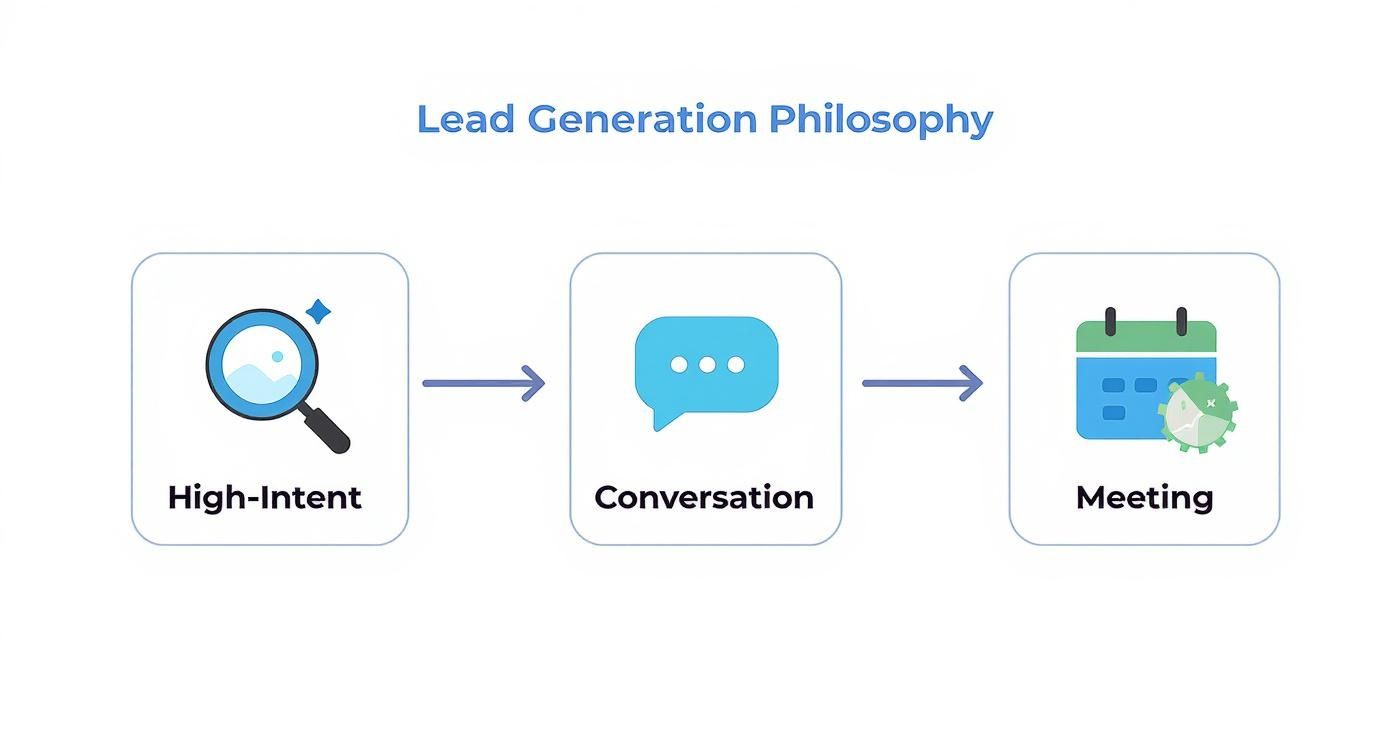
Generating leads on social media isn't about throwing content into the void. As a founder, I learned the hard way that the only thing that works is focusing on high-intent conversations over vanity metrics. It’s about surgically finding people who are actively looking for solutions right now and engaging them with genuine help, not a canned sales pitch. This is our playbook.
Stop Broadcasting and Start Connecting
Let's be direct. Most advice on social media lead generation is theory. As founders, we don't have time or budget for things that don't work. The mindset that transformed our social channels from content graveyards into a predictable lead engine is built on one core philosophy: prioritize qualified meetings, not just likes and follows.
I see so many businesses treat social media like a megaphone. That approach rarely works. Our method is surgical. We pinpoint specific conversations on platforms like Reddit and LinkedIn where potential customers are literally talking about their pain points. For more practical strategies on digital marketing and lead generation, the v30.ai blog is another great resource.
Our Conversation-First Philosophy
Our entire strategy boils down to a few simple principles:
- Go where the problems are: We actively seek out communities where our ideal customers are asking for help. A solid understanding of B2B social listening tactics is your superpower.
- Help first, sell later: We never lead with a sales pitch. Our first interaction is always about offering genuine advice. This is how you build trust.
- Measure what actually matters: Forget follower counts. The only metric we obsess over is the number of meaningful conversations that turn into qualified meetings.
We shifted our entire social media focus from creating content to starting conversations. The result? A predictable stream of high-quality leads who were already problem-aware and ready to talk solutions.
This conversation-first approach is effective because it taps into the very reason these platforms exist—they're built for connection. The data backs this up. Today, 68% of marketers report that social media helps them generate more leads, a trend fueled by the massive user bases on platforms like Facebook.
BillyBuzz Platform Focus for Lead Generation
We don't treat every platform the same. Each has a specific role in our lead generation ecosystem. Here’s how we break it down inside BillyBuzz.
| Platform | Primary Goal | Our Key Tactic | Lead Temperature |
|---|---|---|---|
| High-Intent Problem Solving | Answering specific questions in niche subreddits | Hot | |
| Direct B2B Outreach | Engaging with posts from target accounts & execs | Warm to Hot | |
| Industry Trend Monitoring | Joining real-time conversations via keywords | Warm | |
| Community Engagement | Providing value in relevant B2B Groups | Cold to Warm |
This targeted approach ensures we're spending our time where it counts. In the next sections, I’ll pull back the curtain and show you the exact filters, templates, and alert rules we use to turn these online conversations into revenue.
Find High-Intent Leads on Reddit
Let's talk about Reddit. While most marketers are duking it out on LinkedIn, we've found a goldmine of high-intent conversations hiding in plain sight. This isn't about blasting your message; it's about listening to find people who are actively looking for a solution.
On most social platforms, you're an interruption. On Reddit, you're discovering people who are literally typing out their problems and asking for help. Our process is simple: listen first, help second, and sell last.

As you can see, the path from finding a prospect to booking a meeting is all about adding value, not delivering a hard pitch.
Our Subreddit and Keyword Monitoring System
You can't monitor all of Reddit. Success comes from surgical focus. We zero in on a handful of subreddits where we know our ideal customers—SaaS founders and marketers—hang out.
These are the communities we live in every day:
- r/SaaS: Ground zero for SaaS founders. A perfect hunting ground for pain points.
- r/marketing: A gem for finding discussions around automation and lead gen.
- r/startups: Connect with early-stage founders wrestling with customer acquisition.
- r/Entrepreneur: Similar to r/startups, but with small business owners facing the same growth challenges.
We look for problem-oriented posts. Anything starting with "How are you guys handling X?" or "Looking for a tool that does Y" is a flare gun signaling high buying intent.
Trying to catch these posts manually is madness. That's why we use our own tool, BillyBuzz, to get real-time alerts. (Other solid options like Syften or F5Bot do a great job, too).
The key is setting up smart alerts that cut through the noise. Here are the exact keyword rules we have running inside BillyBuzz right now:
"how to" track mentions"tool for" social listening"alternative to" [Competitor A]"recommend" social monitoring
Someone typing these phrases has a problem they need to solve now. For a much deeper look at this strategy, check out our complete guide on how to get customers from Reddit in 2025.
The Non-Spammy Response Framework
The way you jump into a conversation on Reddit determines everything. Lead with a self-promotional comment, and you'll be downvoted and ignored. Our entire approach is anchored in the Help First, Sell Later framework. Critically, we never mention our product in the first public comment.
Your goal is to be so ridiculously helpful in your public comment that the person has to click on your profile to see who you are. On Reddit, trust is everything.
We use a simple framework—not a rigid script—for our initial replies.
Our Go-To Response Framework
- Acknowledge and Validate: Show you get it.
- Our Template:
Ugh, that's a tough spot. Manually tracking mentions is a massive time-suck, I've been there.
- Our Template:
- Offer Genuinely Actionable Advice: Give them a tip they can use right away, unrelated to your product.
- Our Template:
A couple of things that helped us early on were using specific Google Alerts with boolean operators and keeping a dead-simple spreadsheet.
- Our Template:
- Share a Quick Personal Story: Build a connection by sharing your own experience with their problem.
- Our Template:
We honestly wasted hours every week on this before we finally broke down and built a system to automate it.
- Our Template:
This approach positions you as a helpful expert, not a salesperson. Nine times out of ten, this leads to a follow-up question from the original poster—or better, a direct message asking about that "system" we mentioned.
That's our opening. From there, we take the conversation to DMs, ask a few questions, and then—only then—do we offer a demo. It’s a natural, value-first journey from a public comment to a qualified lead.
Connect with Decision-Makers on LinkedIn
LinkedIn is the heavyweight for B2B, but most people use it wrong. We all get those spammy connection requests. At BillyBuzz, we treat LinkedIn less like a megaphone and more like a scalpel for connecting with the exact decision-makers we want to talk to.
Forget the "spray and pray" method. Our system is built around creating laser-focused lead lists and warming up connections before we hit that "connect" button. It’s how we see a connection acceptance rate of over 30%.

Building a Hyper-Targeted Lead List
LinkedIn Sales Navigator is a non-negotiable in our toolkit. We aren't just searching for job titles; we're hunting for buying signals. For a deep dive, check out these strategies for finding leads on LinkedIn.
Here are the specific filters we layer inside Sales Navigator to build our dream lists:
- Current Job Title: "Head of Marketing," "Growth Manager," or "SaaS Founder."
- Company Headcount: Our sweet spot is 11-50 employees.
- Industry: "Computer Software" and "Marketing & Advertising."
- "Posted on LinkedIn in the last 30 days": This is our secret weapon. It separates active users from lurkers.
- "Changed jobs in the last 90 days": Someone new in their role has a fresh budget and is looking for new tools.
This gives us a manageable, high-quality list of people who are not only the right fit but are active enough to respond.
The Multi-Touchpoint Connection Method
Sending a cold connection request is a coin toss. Our process stacks the odds in our favor by warming up the connection first.
Our Pre-Connection Warm-Up Sequence
- Engage Thoughtfully: For a week before sending a request, we leave genuine, insightful comments on their content. Not just "great post!"
- Share a Relevant Resource: If they post about a challenge, we might reply with a link to a helpful, non-promotional article.
- Send the Connection Request: We only send the request after they've seen our name a couple of times.
This transforms our request from an interruption into a hello from a familiar name.
We don't just send a connection request; we earn it. By showing up in their notifications with valuable comments first, our name is already associated with helpfulness before we ask for the connection.
The data backs this up. By 2025, 40% of B2B marketers are expected to see LinkedIn as their top channel for high-quality leads. Plus, tools like LinkedIn Lead Gen Forms pull in an average conversion rate of 13%, dwarfing the typical landing page average of 2.35%.
Our Proven Outreach Templates
Once someone connects, we don't pitch. The goal is to start a conversation. Here are the templates we use that you can adapt.
Template 1: The Connection Request NoteHi [First Name], saw your recent post on [Topic] and loved your take on [Specific Point]. Really resonated. Would be great to connect and follow your work.
Template 2: The First Follow-Up Message (24 hours after connecting)Thanks for connecting, [First Name]. Saw your team is focused on [Company Goal]. Curious, how are you currently handling [Pain Point] to support that growth?
It's not a sales pitch. It's an open-ended question designed to start a real dialogue. By focusing on their goals, we position ourselves as consultants. From there, we can naturally steer the conversation toward how BillyBuzz might help, but only when the timing is right.
Build Authority in Facebook Groups and on Twitter
While Reddit and LinkedIn are for pinpointing high-intent individuals, our game on Facebook and Twitter is the long play. It’s where we stop hunting and start farming—cultivating trust and building authority so that leads eventually come to us.
This is less about instant gratification and more about cementing BillyBuzz as the go-to resource in our space. When you consistently show up and provide value, people notice. Over time, that recognition turns into DMs and a steady stream of warm inquiries from people who already see you as an expert.
Become the Go-To Expert in Niche Facebook Groups
Facebook Groups are still goldmines, but only if you understand the rules. Blatant self-promotion is the quickest way to get kicked out. Our philosophy is: participate, don't promote.
First, find the right watering holes. We hunt for smaller, engaged communities where our ideal customers—SaaS founders and B2B marketers—are asking for help.
Here’s the kind of groups we prioritize:
- Niche SaaS Communities: Places like "SaaS Growth Hacks" or "Bootstrapped SaaS Founders."
- Industry-Specific Marketing Groups: Communities focused on B2B marketing or product-led growth.
- Tool-Adjacent Groups: Communities built around tools our customers already use, like HubSpot or Salesforce.
Once we're in, the game plan is simple. Our team follows a strict internal guideline: for every one thing we share about our work, we must first drop at least 10 genuinely helpful comments on other people's posts. We answer questions, share insights, and offer solutions that have nothing to do with our product. This is how you build social capital.
The goal in a Facebook Group isn't to find a lead today. It’s to be so consistently helpful that when someone in that group has a problem we can solve, we're the first person they think of.
Eventually, people start tagging you in posts. They send you friend requests. Your DMs light up with messages like, "Hey, I've seen your comments in [Group Name]... Got a second to chat?" That's when you know the strategy is working.
Uncover Real-Time Needs with Twitter Advanced Search
Twitter (now X) is a powerful listening post. We dig into Twitter’s Advanced Search to find people openly asking for solutions. It’s the closest you can get to the high-intent signals we find on Reddit.
We don't just search for broad keywords. We use conversational phrases.
Our Saved Twitter Searches
"anyone know a tool for" social monitoring"recommend a tool for" brand mentions"how do you track" competitors on Reddit"looking for an alternative to" [Competitor Name]
These searches surface tweets from people in the buying cycle right now. When we find one, our approach is the same as our Reddit framework: help first. We’ll reply with a useful tip or ask a clarifying question. We never lead with a link to our site.
Beyond active searching, we use private Twitter Lists to keep an eye on key accounts without flooding our main feed. We have three that are critical:
- Potential Leads: Anyone who has asked a relevant question or engaged with us.
- Industry Influencers: The key voices in SaaS and marketing.
- Happy Customers: To easily find and amplify their content.
This system lets us build relationships organically. By consistently showing up with helpful answers, we’re not just generating leads from social media—we’re building a reputation that brings leads to our door.
From Engagement to Revenue: Making Social Media Pay
Likes and shares are great, but they don't pay the bills. The trick is turning engagement into revenue. At BillyBuzz, we’ve stopped chasing vanity metrics. Instead, we've built a system where every piece of content has a specific job. Short-form video is the best tool for this, but only when it's built with a commercial goal in mind.

Our 'Problem-Agitate-Solve' Video Formula
Every Reel or Short we publish is engineered to do one thing: push viewers toward a specific lead magnet. We use a simple but brutally effective scripting framework called Problem-Agitate-Solve (PAS).
Here’s our internal PAS template:
- Problem (First 3 Seconds): Hit on the main pain point, fast.
- Example: "Still manually checking Reddit for new leads every morning?"
- Agitate (Next 5-7 Seconds): Twist the knife. Remind them why this problem is frustrating.
- Example: "You know you're missing key conversations, and your competitors are swooping in first. It's a huge time-suck with zero guarantee."
- Solve (Final 5-10 Seconds): Offer the solution. The solution isn't your product; it's the lead magnet. Frame it as the immediate answer, followed by a clear call-to-action (CTA).
- Example: "I built a free checklist with the 5 keyword alerts that find 90% of our high-intent leads automatically. Grab it from the link in our bio."
This structure mirrors the customer's emotional journey, positioning our lead magnet as the obvious next step.
Shorten the Funnel with Social Commerce
We're all-in on social commerce features to shorten the sales cycle. The rise of integrated shopping on Instagram and Facebook has been a massive win. Data shows that campaigns using these native features can see conversion rates 3-5 times higher than traditional e-commerce channels. This makes sense when you consider that over 50% of users want to see posts that showcase products.
We use features like Instagram Shops and product tags to make buying or signing up as painless as possible. Why send someone to a clunky landing page? We bring the point of conversion right to them, inside the app.
We treat every social profile like a mini-landing page. The goal is to remove every possible click between a user seeing our content and taking the action we want. Friction is the enemy of conversion.
Tracking What Actually Matters
We ignore most vanity metrics. Views are nice, but they don't tell the whole story. We zero in on a handful of key performance indicators (KPIs) that directly tie social activity to our bottom line.
Our internal dashboard is simple:
- Link Clicks (from Bio): We use Bitly to track every click on the unique link in our bio.
- Landing Page Conversion Rate: Of the people who click, how many fill out the form?
- Cost Per Lead (CPL): When we use ad spend, we calculate the exact cost to acquire each lead.
- Lead-to-Customer Rate: The ultimate metric. Of all leads from a campaign, how many become paying customers?
Keeping a close eye on these numbers gives us a clear picture of what's working. For a deeper dive, check out our guide on measuring social media ROI. This data-driven approach is how we’ve turned our social media into a predictable engine for generating high-quality leads.
Your Top Social Media Lead Gen Questions, Answered
Founders often ask us how we really get leads from social media. It’s a space filled with noise, so let's cut through it. Here are straight answers based on how we've turned social media into a growth engine for BillyBuzz.
How Much Time Does This Actually Take Each Day?
As a founder, your time is everything. The goal isn't to live on social media; it's to make every minute count. We’ve found the magic number is around 45-60 minutes per day. But this has to be focused activity.
This is what that hour looks like in practice:
- 15 minutes: Jump on real-time keyword alerts from Reddit or Twitter. Find fresh conversations and offer genuine help.
- 20 minutes: Focus on LinkedIn engagement. Leave insightful comments on posts from our target account list.
- 10 minutes: Pop into our core Facebook Groups. Answer one or two relevant questions thoroughly.
The real secret is consistency, not intensity. A focused hour every day is a hundred times more effective than an eight-hour blitz once a week. That daily effort compounds.
What Are The Must-Have Tools On a Startup Budget?
You do not need a massive tech stack. Overspending on shiny software is an easy way to burn cash. We believe in starting lean.
Here’s the bare-minimum toolkit we stand by:
- A Social Monitoring Tool: This is non-negotiable. You need a way to find high-intent conversations. We built BillyBuzz to do this on Reddit, but a tool like Syften can also work.
- LinkedIn Sales Navigator: If you sell to B2B, this is an investment, not an expense. The advanced search filters are critical for building hyper-targeted prospect lists.
- A Simple Scheduler: Something low-cost like Buffer or Later is nice for batching content, but it’s far less important than a real-time monitoring tool for finding active buyers.
How Do I Know If This Is Actually Working?
Forget vanity metrics. Likes, shares, and follower counts don't pay the bills. The only way to measure ROI is to track the direct path from a social interaction to cash.
We use a simple, three-step funnel:
- Meaningful Conversations Started: How many new DMs or email threads did we kick off from social this week?
- Qualified Demos Booked: Out of those conversations, how many turned into a scheduled demo with a good-fit prospect?
- New Customers Acquired: The only metric that truly matters. How many of those demos became paying customers?
When you connect these three dots, you can draw a straight line from a helpful comment on Reddit to new MRR. That’s the only ROI that matters.
Stop missing out on high-intent conversations happening right now. BillyBuzz uses AI to find your next customer on Reddit and sends you real-time alerts so you can be the first to respond. Start your free trial at https://www.billybuzz.com.
